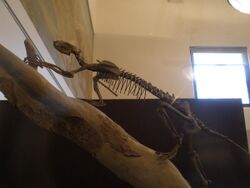Biology:Miacoidea
| Miacoidea | |
|---|---|

| |
| Vulpavus ovatus | |
| Scientific classification | |
| Domain: | Eukaryota |
| Kingdom: | Animalia |
| Phylum: | Chordata |
| Class: | Mammalia |
| Clade: | Carnivoramorpha |
| Superfamily: | †Miacoidea Cope, 1880 |
| Families | |
Miacoidea is a paraphyletic superfamily that had been traditionally divided into two families of carnivores: Miacidae (the miacids) and Viverravidae. Miacoids were primitive carnivores that lived during the Paleocene and Eocene Epochs, about 66-33 million years ago. Today, Miacidae is recognized as a paraphyletic array of stem taxa that probably resulted in some "miacid" genera ending up just outside the order Carnivora, the crown-group within the Carnivoramorpha. Carnivoramorpha consists of both Miacoidea and Carnivora, but excludes the order Creodonta that existed alongside Carnivoramorpha. Miacoids are regarded as basal carnivoramorphs. The miacids are a paraphyletic group containing all miacoids that are not viverravids.
The transition from miacids to Carnivora was a gradual trend during the Paleocene to late Eocene, with taxa from both North America and Eurasia involved. The miacids did not appear until the very end of the Paleocene and are characterized by their shorter skull, and loss of contact between the calcaneum and fibula in the ankle.
Miacoids were mostly small carnivores superficially reminiscent of martens or civets. They probably fed on invertebrates, lizards, birds and smaller mammals like shrews and opossums, while others may have been insectivores. Some species were arboreal, others lived on the ground. Their teeth and skull show that the miacoids were less developed than modern carnivores.
Classification
- Clade Carnivoramorpha
- Superfamily †Miacoidea
- Family †Miacidae
- genera: Eosictis, Miacis, Miocyon, Oodectes, Palaearctonyx, Paramiacis, Paroodectes, Prodaphaenus, Quercygale, Tapocyon, Uintacyon, Vassacyon, Vulpavus, Xinyuictis
- Family †Viverravidae
- genera: Bryanictis, Didymictis, Ictidopappus, Pappidictops, Pristinictis, Protictis, Raphictis, Simpsonictis, Viverravus
- Family †Miacidae
- Superfamily †Miacoidea
References
Wikidata ☰ Q2634940 entry

